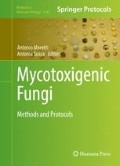Abstract
Real-time polymerase chain reaction (PCR) is a molecular biology technique based on the detection of the fluorescence produced by a reporter molecule, which increases as the reaction proceeds proportionally to the accumulation of the PCR product within each amplification cycle. The fluorescent reporter molecules include dyes that bind to the double-stranded DNA (i.e., SYBR® Green) or sequence-specific probes (i.e., Molecular Beacons or TaqMan® Probes). Real-time PCR provides a tool for accurate and sensitive quantification of target fungal DNA. Here, we describe a TaqMan real-time PCR method for specific detection and quantification of Alternaria spp. The method uses Alternaria-specific primers and probe, targeting the internal transcribed spacer regions ITS1 and ITS2 of the rRNA gene, and a positive amplification control based on 18S rRNA gene.
Access this chapter
Tax calculation will be finalised at checkout
Purchases are for personal use only
References
Barkai-Golan R, Paster N (2008) Mouldy fruits and vegetables as a source of mycotoxins: part 1. World Mycotoxin J 1:147–159
Ostry V (2008) Alternaria mycotoxins: an overview of chemical characterization, producers, toxicity, analysis and occurrence in foodstuffs. World Mycotoxin J 1:175–188
Logrieco A, Moretti A, Solfrizzo M (2009) Alternaria toxins and plant diseases: an overview of origin, occurrence and risks. World Mycotoxin J 2:129–140
Liu GT, Qian YZ, Zhang P et al (1992) Etiological role of Alternaria alternata in human esophageal cancer. Chin Med J 105:390–400
Simmons EG (2007) Alternaria. An identification manual. CBS Fungal Biodiversity Centre, Utrecht
European Food Safety Authority (EFSA) (2011) Scientific opinion on the risks for animal and public health related to the presence of Alternaria toxins in feed and food. EFSA J 9:2407
Scheu P, Berghof MK, Stahl U (1998) Detection of pathogenic and spoilage microorganisms in food with the polymerase chain reaction. Food Microbiol 15:13–31
Chou H, Wu W (2002) Phylogenetic analysis of internal transcribed spacer regions of the genus Alternaria, and the significance of filament-beaked conidia. Mycol Res 106:164–169
Konstantinova P, Bonants P, van Gent-Pelzer M (2002) Development of specific primers for detection and identification of Alternaria spp. in carrot material by PCR and comparison with blotter and plating assays. Mycol Res 106:23–33
Zur G, Shimoni EM, Hallerman E, Kashi Y (2002) Detection of Alternaria fungal contamination in cereal grains by a polymerase chain reaction-based assay. J Food Prot 65:1433–1440
Hong SG, Liu D, Pryor BM (2005) Restriction mapping of the IGS region in Alternaria spp. reveals variable and conserved domains. Mycol Res 109:87–95
Morgenstern I, Powlowski J, Ishmael N et al (2012) A molecular phylogeny of thermophilic fungi. Fungal Biol 116:489–502
Nishikawa J, Nakashima C (2015) Morphological variation and experimental host range of Alternariacinerariae. Mycoscience 56:141–149
Ntasiou P, Myresiotis C, Konstantinou S et al (2015) Identification, characterization and mycotoxigenic ability of Alternaria spp. causing core rot of apple fruit in Greece. Int J Food Microbiol 197:22–29
Thompson AH, Narayanin CD, Smith MF, Slabbert MM (2011) A disease survey of Fusarium wilt and Alternaria blight on sweet potato in South Africa. Crop Prot 30:1409–1413
Cramer RA, Lawrence CB (2004) Identification of Alternaria brassicicola genes expressed in planta during pathogenesis of Arabidopsis thaliana. Fungal Genet Biol 41:115–128
Kusaba M, Tsuge T (1995) Phylogeny of Alternaria fungi known to produce host-specific toxins on the basis of variation in internal transcribed spacers of ribosomal DNA. Curr Genet 28:491–498
Polizzotto A, Andersen B, Martini M et al (2012) A polyphasic approach for the characterization of endophytic Alternaria strains isolated from grapevines. J Microbiol Methods 88:162–171
Vujanovic V, Labrecque M (2008) Potentially pathogenic and biocontrol Ascomycota associated with green wall structures of basket willow (Salix viminalis L.) revealed by phenotypic characters and ITS phylogeny. Biocontrol 53:413–426
Pavón MA, González I, Rojas M et al (2011) PCR detection of Alternaria spp. in processed foods, based on the internal transcribed spacer genetic marker. J Food Prot 74:240–247
Pavón MA, González I, Pegels N et al (2010) PCR detection and identification of Alternaria species-groups in processed foods based on the genetic marker Alt a 1. Food Control 21:1745–1756
Gil-Serna J, González-Salgado A, González-Jaén MT et al (2009) ITS-based detection and quantification of Aspergillusochraceus and Aspergilluswesterdijkiae in grapes and green coffee beans by real-time quantitative PCR. Int J Food Microbiol 131:162–167
Pavón MA, González I, Martín R, García T (2012) ITS-based detection and quantification of Alternaria spp. in raw and processed vegetables by real-time quantitative PCR. Food Microbiol 32:165–171
Martín I, García T, Fajardo V et al (2009) SYBR-Green real-time PCR approach for the detection and quantification of pig DNA in feedstuffs. Meat Sci 82:252–259
Acknowledgments
This work was supported by Grant No. AGL 2006-07659 from the Ministerio de Educación y Ciencia of Spain and the Programa de Vigilancia Sanitaria 2009/AGR-1489 from the Comunidad de Madrid (Spain).
Author information
Authors and Affiliations
Corresponding author
Editor information
Editors and Affiliations
Rights and permissions
Copyright information
© 2017 Springer Science+Business Media LLC
About this protocol
Cite this protocol
Pavón, M.Á., López-Calleja, I.M., González, I., Martín, R., García, T. (2017). Targeting Conserved Genes in Alternaria Species. In: Moretti, A., Susca, A. (eds) Mycotoxigenic Fungi. Methods in Molecular Biology, vol 1542. Humana Press, New York, NY. https://doi.org/10.1007/978-1-4939-6707-0_6
Download citation
DOI: https://doi.org/10.1007/978-1-4939-6707-0_6
Published:
Publisher Name: Humana Press, New York, NY
Print ISBN: 978-1-4939-6705-6
Online ISBN: 978-1-4939-6707-0
eBook Packages: Springer Protocols

